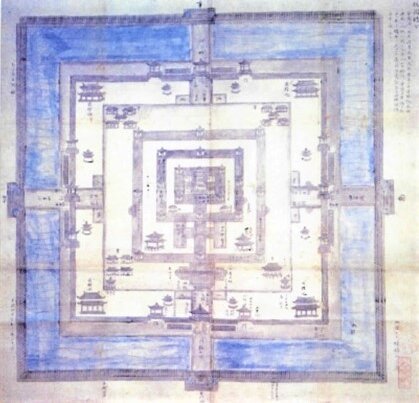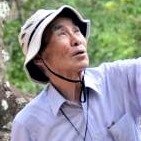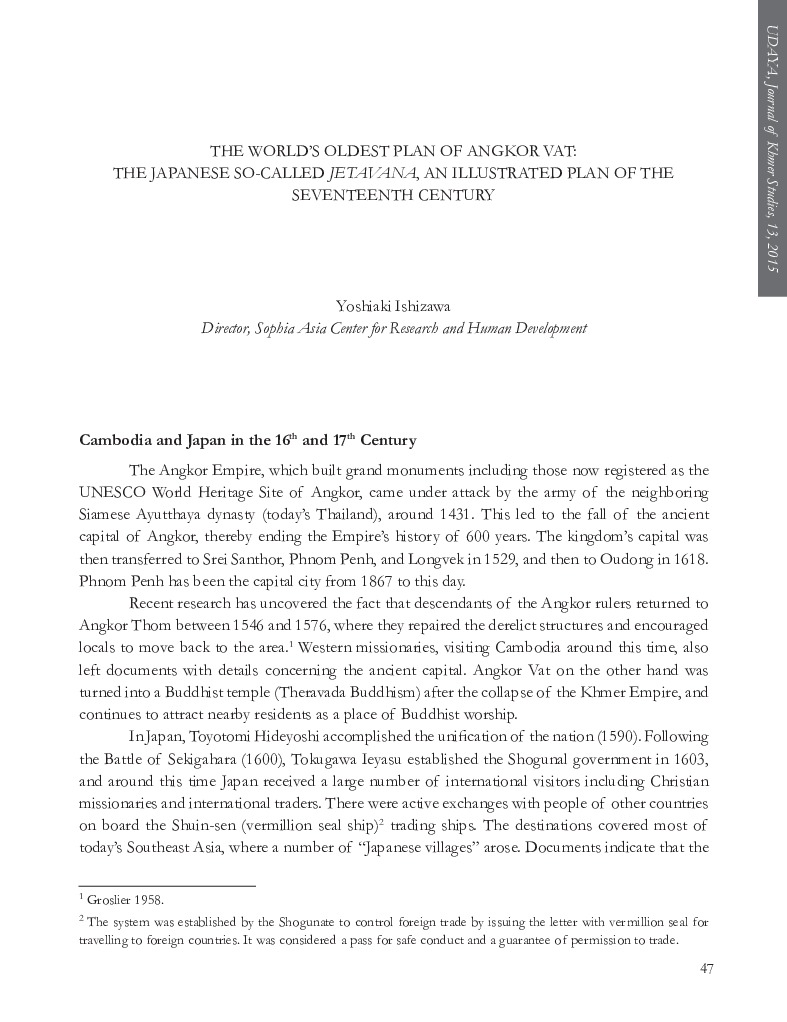The World's Oldest Plan of Angkor: The Japanese so-called Jetavana, an Illustrated Plan of the Seventheeth Century
by Yoshiaki Ishizawa
Who drew the very first known plan of Angkor Wat, the "Jetavana"?

Publication: Udaya, Journal of Khmer Studies, vol.13: 47-61.
Published: 2015
Author: Yoshiaki Ishizawa
Pages: 14
Languages : English, Japanese
pdf 1.4 MB
Mentioned in B.P. Groslier’s essay on the historiographical sources about Angkor from the 17th century, studied by EFEO researcher Noël Pieri in 1923, this colored plan with Japanese annotations has been attributed to a Japanese interpreter visiting the court of King Satha during the brief “revival” period of Angkor circa 1632, Shimano Kenryo.
Vividly profiling the numerous travelers from Japan who sailed to Cambodia on the “Shui-sen” (vermillion seal ships) at this period, leaving inscriptions and even establishing villages around Angkor, the author reconstructs the life of Morimoto Ukondayu Kazufusa (森本右近太夫一房) (d. May 3, 1674 Kyōto), ending with his sepulture in Kyoto. Ukondayu was not a merchant but “an attendant of the Fujiwara clan” who took such a long journey for a pious purpose: “offering four Buddha images in a ritual to cleanse and purify the soul of those living and those deceased”.
ADB Input:
- Yoshiaki Ishizawa’s input is that Shimano Kenryo was probably an alias, and Ukondaya most possibly the author of the map. Jetavana (‘Jeta’s Grove’) was one of the most famous of the Buddhist monasteries or viharas in India (present-day Uttar Pradesh), the second vihara donated to Gautama Buddha after the Venuvana in Rajgir. According to one tradition, the donor was Prince Jetri (Jeta in pali), a son of Prasenajit, ruler of the Kosala kingdom in ancient India. Another version is that the donor was Anathapindika, the richest merchant in the old town of Savatthi. After his death, he became a deva and spoke these words to the Buddha:
“O blessed is this Jeta Grove, frequented by the holy Order,
Where the Dhamma King resides, the fount of all my happiness.
By deeds, by knowledge, by righteousness,
By virtue, by the sublimest life,
By these are mortals purified, and not by lineage nor by wealth.
A wise man, therefore, seeing his own good,
Wisely will he choose the Dhamma, that he may thus be purified.
Like Sariputta in his wisdom, in his virtue, and in highest peace,
At best a bhikkhu who has gone across, can only equal him.”
(translation by Hellmut Hecker in ‘Anathapindika, The Great Benefactor’)
- This article elaborates from a previous study: Ishizawa, Yoshiaki: Les inscriptions calligraphiques japonaises du XVIIe siècle à Angkor Vat et le plan du Jetavana-vihāra, in: Manuel d’épigraphie du Cambodge. Eds.: Yoshiaki Ishizawa, Claude Jacques, Khin Sok. With Uraisi Varasarin, Michael Vickery, Tatsuro Yamamoto. Vol. I, Paris 2007, pp. 169 – 179.
- According to Masako and Stan Fukawa, “at least fourteen Japanese inscriptions have been found in the Angkor area. One of the most renowned Japanese inscriptions belonged to Ukondayu Kazufusa who had visited Angkor and celebrated Khmer’s New Year there in the year 1632.”
- The Jetavana is kept at the Shokokan Museum in Mito, Japan.
- Further reading: Abdoul-Carime, Nasir, “Au-delà de la représentation d’Angkor Vat sur un plan japonais du XVIIe siècle.” Péninsule 63⁄2 (2011): 61 – 72.
- Further reading: “Journeys to Jetavana : Poetic and Ideological Elaborations of Remembrance of Jetavana in Southeast Asia”, Buddhist Narrative in Asia and Beyond, in Honour of HRH Princess Maha Chakri Sirindhorn on Her Fivety-Fifth Birth Anniversary, Peter Skilling and Justin McDaniel eds., Bangkok, Institute of Thai Studies, Chulalongkorn University, vol. 1. p. 167 – 193.
Photo: Yoshiaki Ishiwara in Angkor in 2017 (Photo Japan Times/Sophia University)
Tags: Japan, maps & plans, Jetavana, 17th century, Buddhist pilgrims
About the Author

Yoshiaki Ishizawa
A former president of Sophia University (Tokyo), archaeologist and historian Yoshiaki Ishizawa 石沢 良昭 (b. 19 Sept. 1937, Hokkaido, Japan) has spent many years on the field, actively involved in the restoration and preservation of Angkor Wat, where he was the head of the International Mission on Angkor, starting a sustained mission right after the Cambodian civil war in 1980.
While furthering his archaeological and historical research, Yoshiaki Ishizawa greatly contributed in the training of new generations of Cambodian and Japanese archaeologists and conservationists. His reports were instrumental in the inscription of Angkor to UNESCO World Heritage List, and his leadership in field research led to major discoveries, in particular the Banteay Kdei depository of Buddha statues which initiated the establishment of the Preah Sihanouk Museum in Siem Reap in 2007.
His essays in history reflect a constant attention to cultural and economic background, a transnational vision like in Along the Royal Roads of Angkor — an exploration of Khmer architectural remains across modern Thailand, Laos and Vietnam — and Angkor Buddhist treasures from Banteay Kdei (with photographs by Tsugusato Omura). Alongside important contributions by Claude Jacques, Michael Vickery, O.W. Wolters, Nhim Sotheavin, Ang Choulean, and other researchers, his approach to Chinese sources on Ancient Cambodia stimulated the discussion on pre-Angkorian history, in particular the Indianization and Sinization processes.
Publications
- “Etudes d’histoire angkorienne (I) : les rapports concrets entre Pura (domaine temporel) et Dron Vrah (domaine du dieu)”, The Southeast Asian studies, Kyoto University, vol. 10, 4, 1973 : 561 – 582.
- “Etudes d’histoire angkorienne (II) : Les biens du dieu à Sam Paribhoga (co-bénéficiaire) et à Pre Siddhi (droit exclusif) “, The Southeast Asian studies 11 – 1, Kyoto University, 1973 : 49 – 61.
- “Étude critique sur le Zhenla Zhuan du Sui Shu”, Historical Science Report, Kagoshima University, vol. 29, July 1980 : 1 – 11.
- “Recherché sur Angkor Vat et la ruine qui le menace — Angkor attend des secours”, Historical Science Report, Kagoshima University, vol. 30, July 1981 : 1 – 34.
- 『古代カンボジア史研究』国書刊行会 [Studies on the History of Ancient Cambodia], Tokyo, Kokusho Kankokai, 1982.
- “Angkor Vat menacé de destruction : Recherches sur l’état actuel des Ruines d’Angkor”, The Journal of Sophia Asian Studies (JSAS), 1, 1983: 56 – 101.
- “The preservation of law and order in Angkorian Cambodia “, JSAS, 2, 1984: 11 – 31.
- “The juridical system in Angkorian Cambodia “, JSAS, 3, 1985: 21 – 53.
- “The Angkor Complex, its Study and Preservation”, in Cultural Heritage in Asia – Study and Preservation of Historic Cities of Southeast Asia, Tokyo, Japan Times, 1986 : 124 – 137.
- “Les traits généraux de l’histoire médiévale du Cambodge dans ses relations avec le Champa, le Laos et le Siam”, JSAS 4, 1986: 13 – 26.
- “Christianisme et Sociétés Asiatiques — Acceptation et Refus du Christianisme dans l’Asie du Sud-Est Continentale”, JSAS 5, 1987: 17 – 26.
- “Usurpation royale et symbiose des familles religieuses et du pouvoir”, JSAS 6, 1988: 49 – 62.
- “Puissances locales dans le Cambodge ancien (VII°-IX° siècles) : Sambhupura et Aninditapura — Étude comparative et critique à partir des matériaux épigraphiques et des sources chinoises”, JSAS 7, 1989: 82 – 100.
- “Angkor Vat en péril : les dix dernières années”, JSAS 8, 1990: 44 – 54.
- [ed. with Alain Forest & Léon Vandermeersch], Cultes populaires et sociétés asiatiques : appareils cultuels et appareils de pouvoir (Actes du 4º Séminaire franco-japonais ” Religions et sociétés asiatiques ”), Paris, L’Harmattan, 1991, 266 p.
- “International Cooperation for the Preservation of Cultural Property — Through the Restoration of the Four Great Monuments in South-East Asia”, Renaissance culturelle du Cambodge (RCC), 3, 1991: 17 – 26 & 131 – 138.
- [with Kono Yasushi, Moriai Tomio, Fujiki Yoshiaki & Endo Nobuo] “Renaissance Culturelle du Cambodge”, RCC, 4, 1991: 240 – 322.
- “Greatest Treasure Ruined beyond Imagination — Survey Report on the Angkor Monuments (1980−1993)”, JSAS, 10, 1992: 104 – 109.
- “Policy for the Sophia University Survey Mission for the Study and Preservation of the Angkor Monuments — Principles and Proposals”, RCC, 7, 1992: 131 – 137.
- [with Takahashi Hiroaki, Moriai Tomio & Endo Nobuo] “Eighth Sophia University Survey Mission for the Study and Preservation of the Angkor Monuments”, RCC, 8, 1993: 189 – 369.
- “Chinese Chronicles of 1 – 5th Century AD: Funan, Southern Cambodia”, in South East Asia & China : art, interaction & commerce, Colloquies on Art and Archaeology in Asia, no. 17 (6 – 18 June 1994), London/Singapore, Percival David Foundation of Chinese Art, SOAS, University of London/Sun Tree Publishing, 1995: 11 – 32.
- [with Claude Jacques] “Khmer History : 2. The Sophia University Angkor International Survey Mission since 1980”, Renaissance Culturelle du Cambodge (RCC) 11, Institute of Asian Cultures, Sophia University, 1995, p. 202 – 206.
- [with Endo Nobuo] “Creation of a Survey Model of the Socio-Cultural Development of Banteay Kdei Area- Historical Monuments and Sites, Villages and Forests”, RCC, 11, 1995: 207 – 216.
- [with Claude Jacques] “The Sophia University Angkor International Survey Mission since 1980”, RCC, 11, 1995: 202 – 204.
- 『アンコール・ワット 大伽藍と文明の謎』講談社現代新書 [Angkor Wat: The Mystery of the Great Temple and Civilization], Kodansha Gendaishinsho, 1996.
- “Training Project 1991 – 1995: A Profile — Concept and Profile of the Project for Training Cambodian Specialists as It Enters Its 5th Year”, RCC, 12, 1996: 213 – 224.
- “Les études japonaises sur le Cambodge”, in Pierre L. Lamant (dir.), Bilan et perspectives des études khmères (Langue et culture), Paris, L’Harmattan, 1997 : 233 – 237.
- “Les quartiers japonais dans l’Asie du Sud-Est au XVIII° siècle”, in Nguyên Thê Anh et Alain Forest (dir.), Guerre et paix en Asie du Sud-Est. Paris, L’Harmattan, 1998 : 85 – 95.
- “Human Resources and Cultural Development — A Case Study of the Angkor Monument”, RCC, 15, 1999: 276 – 285.
- [with Katagiri Masao] “Travaux de restauration de la chaussée-digue du passage ouest a Angkor Vat”, RCC, 15, 1998: 207 – 234.
- Along the Royal Roads to Angkor, New-York, Weatherhill, 1999, 199 p.
- “Training Project 1991 – 1999: Project for Training Cambodian Specialists Enters 9th Year”, RCC, 16, 1999: 283 – 287.
- [ed. with Nguyễn Thế Anh], Commerce et navigation en Asie du Sud-Est (XIV°-XIX°s), Paris, L’Harmattan, 1999, 190 p.
- 『アンコール・ワットへの道』JTB出版部 [The Roads to Angkor Wat], JTB Publishing, 2000.
- “From the Study of Cultural Properties to the Science of Cultural Heritage — A Methodology for the Creation of an Innovative System for the Acquisition of Knowledge, and for the Fusion of Borderless and Differentiated Disciplines “, JSAS, 18, 2000: 181 – 190.
- “Learning from the Age-Old Wisdom of Asia : Two International Symposia : From Sophia to Asia, and on to the Global Society”, JSAS, 18, 2000: 1 – 6.
- “An Outline of the Activities of the Sophia University International Angkor Mission(1999 – 2000)”, RCC, 17, 2000: 185 – 187.
- “A Comparative Study of Material contained in Inscriptions and the 1: 5,000 Scale Topographical Map : Considering the Hydraulic City of the Angkor Dynasty (The Hydraulic City in Asia : The Huge Monuments in terms of the Relationship between Agriculture and Water)”, JSAS, 18, 2000: 9 – 25.
- “New Aspects of the Angkor Dynasty : Report on the Discovery of the Stone Pillars of the Thousand Seated Buddhas and 274 Discarded Buddhist Statues”, JSAS, 19, 2001: 233 – 265.
- [with photographs by Hitoshi Tamura] Along the royal roads to Angkor, New York/Tokyo, Weatherhill, 2001, 199 p. ISBN: 0834804727.
- “An Outline of the Activities of the Sophia University International Angkor Mission (2000−2001)”, RCC, 18, 2001: 259 – 261.
- 『アンコールからのメッセージ』山川出版社 [Message from Angkor], Yamakawa Publishing, 2002.
- “Cambodia’s History and Culture “, in Country Study for Japan’s Official Development Assistance to the Kingdom of Cambodia – From Reconstruction to Sustainable Development –, Tokyo, Japan International Cooperation Agency, 2002 : 79 – 99.
- “La découverte de 274 sculptures et d’un caitya bouddhique des campagnes de fouilles de 2000 et 2001 au temple de Banteay Kdei a Angkor “, Arts Asiatiques, 2002 : 206 – 218.
- “Angkor Wat Environmental Education Project”, RCC, 20, 2003: 229 – 235.
- “Cultural, Heritage, Identity, and Information Technology — Angkor Wat and the use of Three Dimensional Imaging Technology”, RCC, 20, 2003: 223 – 228.
- “Establishment of the Sihanouk-Aeon Angkor Sites Museum”, RCC, 20, 2003: 217 – 222.
- “Reconsideration of Indianization and Sinization in the History of Mainland Southeast Asia”, RCC, 20, 2003: 236 – 242.
- “Reconsidering on the history of the Angkor dynasty. A Confirmation of the Prosperity of the Late Angkor Period (Special Issue on the Inventory of 274 Buddhist Statues and the stone Pillar Discovered from Banteay Kdei Temple)”, RCC, 21, 2004: 3 – 40.
- [with Claude Jacques & Uneao Kunikazu] “Panel discussion: Major Discoveries that Overturn the Popular View of the History of the Angkor Dynasty (Special Issue on the Inventory of 274 Buddhist Statues and the stone Pillar Discovered from Banteay Kdei Temple)”, RCC, 21, 2004: 155 – 163.
- [with Omura Tsugusato] “Photos of discovered Buddhist statues (Special Issue on the Inventory of 274 Buddhist Statues and the stone Pillar Discovered from Banteay Kdei Temple) — (catalogue — Statues excavated from DU04, Banteay Kdei)”, RCC, 21, 2004: 173 – 229.
- “Promotion of international cooperation to aid cultural heritage education strategy”, RCC, 22, 2005: 213 – 217.
- 『アンコール・王たちの物語』NHK出版 [The Story of the Kings of Angkor], NHK Publishing, 2005.
- [ed. with Claude Jacques & Khin Sok], Manuel d’épigraphie du Cambodge, Paris, Ecole française d’Extrême-Orient, vol. 1, 2007, 216 p.
- “Les inscriptions calligraphiques japonaises du XVIIe siècle à Angkor Vat et le plan du Jetavana-Vihara”, Manuel d’épigraphie : 169 – 179.
- “Sixteen years of grassroots international cooperation: my experiences of museum-building, restoration work, and graduate education in Cambodia”, RCC, 23, 2007 : 173 – 178.
- 『興亡の世界史 東南アジア 多文明世界の発見』講談社 [The Rise and Fall of the World History: Southeast Asia, Discovery of a Multi-Civilization World], Kodansha, 2009.
- Angkor Buddhist Treasures from Banteay Kdei | Preah Norodom Sihanouk Angkor Museum, Tokyo/Siem Reap, NHK Publishing, 2007, 95 p.
- “The World’s Oldest Plan of Angkor Wat: The Japanese so-called Jetavana, an Illustrated Plan of the Seventheeth Century”, Udaya 13, 2015: 47 – 61.
- 『アンコール・ワットと私』連合出版 [Angkor Wat and I], Rengo Publishing, 2018.
- 『アンコール王朝興亡史』[“The Rise and Fall of the Angkor Dynasty”], NHK Publishing, 2021.
- ト建立の経済活動解明に挑戦』ぎょうせい [The Water City of the Angkor Dynasty: Uncovering the Economic Activities Behind the Construction of Angkor Wat], Gyosei, 2023.

